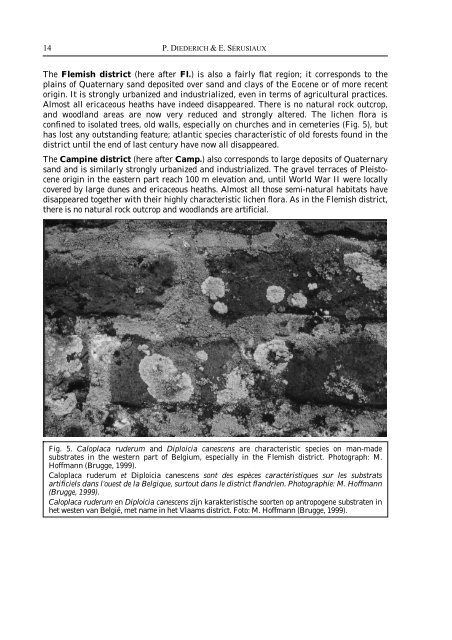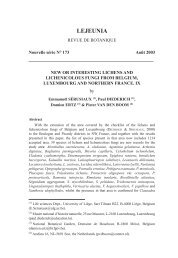The Lichens and Lichenicolous Fungi of Belgium and Luxembourg ...
The Lichens and Lichenicolous Fungi of Belgium and Luxembourg ...
The Lichens and Lichenicolous Fungi of Belgium and Luxembourg ...
You also want an ePaper? Increase the reach of your titles
YUMPU automatically turns print PDFs into web optimized ePapers that Google loves.
14 P. DIEDERICH & E. SÉRUSIAUX<br />
<strong>The</strong> Flemish district (here after Fl.) is also a fairly flat region; it corresponds to the<br />
plains <strong>of</strong> Quaternary s<strong>and</strong> deposited over s<strong>and</strong> <strong>and</strong> clays <strong>of</strong> the Eocene or <strong>of</strong> more recent<br />
origin. It is strongly urbanized <strong>and</strong> industrialized, even in terms <strong>of</strong> agricultural practices.<br />
Almost all ericaceous heaths have indeed disappeared. <strong>The</strong>re is no natural rock outcrop,<br />
<strong>and</strong> woodl<strong>and</strong> areas are now very reduced <strong>and</strong> strongly altered. <strong>The</strong> lichen flora is<br />
confined to isolated trees, old walls, especially on churches <strong>and</strong> in cemeteries (Fig. 5), but<br />
has lost any outst<strong>and</strong>ing feature; atlantic species characteristic <strong>of</strong> old forests found in the<br />
district until the end <strong>of</strong> last century have now all disappeared.<br />
<strong>The</strong> Campine district (here after Camp.) also corresponds to large deposits <strong>of</strong> Quaternary<br />
s<strong>and</strong> <strong>and</strong> is similarly strongly urbanized <strong>and</strong> industrialized. <strong>The</strong> gravel terraces <strong>of</strong> Pleistocene<br />
origin in the eastern part reach 100 m elevation <strong>and</strong>, until World War II were locally<br />
covered by large dunes <strong>and</strong> ericaceous heaths. Almost all those semi-natural habitats have<br />
disappeared together with their highly characteristic lichen flora. As in the Flemish district,<br />
there is no natural rock outcrop <strong>and</strong> woodl<strong>and</strong>s are artificial.<br />
Fig. 5. Caloplaca ruderum <strong>and</strong> Diploicia canescens are characteristic species on man-made<br />
substrates in the western part <strong>of</strong> <strong>Belgium</strong>, especially in the Flemish district. Photograph: M.<br />
H<strong>of</strong>fmann (Brugge, 1999).<br />
Caloplaca ruderum et Diploicia canescens sont des espèces caractéristiques sur les substrats<br />
artificiels dans l’ouest de la Belgique, surtout dans le district fl<strong>and</strong>rien. Photographie: M. H<strong>of</strong>fmann<br />
(Brugge, 1999).<br />
Caloplaca ruderum en Diploicia canescens zijn karakteristische soorten op antropogene substraten in<br />
het westen van België, met name in het Vlaams district. Foto: M. H<strong>of</strong>fmann (Brugge, 1999).





